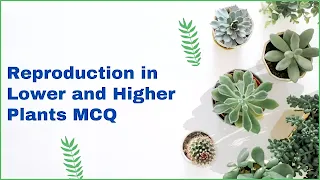MCQ Questions on Reproduction in Lower and Higher Plants for NEET :
Hello Students In this Article, We provided Important Multiple Choice Questions on Reproduction in Lower and Higher Plants and Answers with detailed solutions. This MCQ or Objective Question Bank is available Free of Cost for Each and Every Student.
Important Points to Remember about Reproduction in Lower and Higher Plants :
- Reproduction is the process of production of new similar organisms from their parents.
- In plants there are two modes of reproduction, asexual and sexual. There are several methods of asexual reproduction such as fragmentation, spore formation and vegetative propagation like cutting, grafting, budding, layering, division, sectioning of rhizomes, roots, tubers, bulbs, stolons, tillers, etc.
- Sexual reproduction involves the fusion of male and female gametes.
- Asexual reproduction does not involve the production and fusion of male and female gametes.
- Sexual reproduction produces offspring by the fusion of gametes, resulting in offspring genetically different from the parent or parents.
- The fusion of male and female gametes (fertilization) produces a diploid zygote, which develops by mitotic cell divisions into a multicellular sporophyte.
MCQ on Reproduction in Lower and Higher Plants:
Answer: A
2. In ovule, meiosis occurs in______________
Answer : D
3. The ploidy level is NOT the same in____________
Answer : C
4. Which of the following types require pollinator but result is genetically similar to autogamy?
Answer : A
5. If diploid chromosome number in a flowering plant is 12, then which one of the following will have 6 chromosomes?
Answer : D
6. In angiosperms, endosperm is formed by/ due to___________
Answer : C
Answer : D
19. Lever mechanisim of pollination is observed in_________
(a) Salvia
(b) Jasmine
(c) Bougainvillea
(d) Butea
Answer: A
20. Identify the wrong one from the following : In an orthotropous ovule_________
(a) the micropyle and chalaza are in one
straight line
(b) the micropyle and funicle are in one
straight line
(c) the funicle, embryo sac, micropyle and
style are all in one straight line
(d) the funicle, chalaza, embryo sac, micropyleare not in one straight line
Answer: C
21. Type of pollination in Vallisneria is_________
(a) anemophily
(b) hydrophily
(c) omithophily
(d) entomophily
Answer: B
22. The product of syngamy leads to the
formation of_________
(a) endosperm
(b) embryo
(c) perisperm
(d) cotyledon
Answer: B
23. In angiosperms, fertilization occurs________
(a) in the stamen
(b) when the male gamete fuses with an egg cell
(c) on the outer surface of the ovary
(d) some time after pollination
Answer: B
24. In Helobial type of endosperm development__________
(a) first only nuclei divides
(b) only first division is followed by cytokinesis
(c) every nuclei division accompained by
cytokinesis
(d) only second division is followed by auxin
Answer: B
25. Entomophilous flowers usually shows modified structures like________
a) tiny flowers with white colour
b) dry pollens with smooth surface
c) light weight, bright coloured pollen
d) sticky pollen with rough surface
Answer: D
